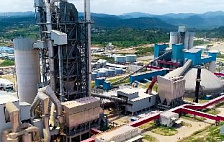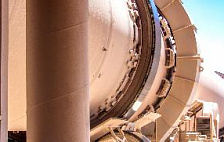- Heidelberg Materials celebrates the opening of its new cement plant in Mitchell, Indiana, the second-largest single cement production facility in North America.
- The state-of-the-art plant will substantially increase local production levels while significantly reducing CO₂ emissions and energy consumption for Heidelberg Materials North America.
- The project, realised on time and on budget despite disruptions from the coronavirus pandemic, is the result of a several-year construction period and an investment of more than US$600 million.
Yesterday, Heidelberg Materials celebrated the opening of its new cement plant in Mitchell, Indiana. The state-of-the-art facility will be the second largest cement plant in North America with a capacity of 2.4 million tonnes of cement a year, and one of the most technologically advanced and sustainable ever built. Heidelberg Materials' management joined customers, partners, as well as federal, state, and local officials to cut the ribbon.
“Our Mitchell project instills pride in our rich history and provides an exciting look into the future of cement production at the same time,” said Heidelberg Materials CEO Dr Dominik von Achten: “The plant will substantially contribute to Heidelberg Materials’ offering of low-carbon cement and concrete – it is the springboard to become the first fully decarbonised cement plant in the USA. It represents our commitment to further strengthening our North American footprint and increasing the sustainability of our products.”
”The plant will reduce clinker production carbon dioxide emissions per tonne of product by almost 30% mainly through operating on natural gas,” said Chris Ward, member of the Managing Board and responsible for the North America Group area. “Our investment in the Mitchell facility helps us lower our carbon footprint while serving the growing demand for more sustainable products in this key market.”
Mitchell is also where Heidelberg Materials’ largest Carbon Capture, Utilisation, and Storage (CCUS) project to date will be located: The company aims to capture 95% of the CO₂ emissions from the newly renovated production facility and store them in a local onshore reservoir in the Illinois Basin by 2030. This corresponds to an emission reduction of approximately 2 million tonnes of CO₂ per year. Heidelberg Materials is currently conducting a feasibility study at the site, supported by the U.S. Department of Energy.
The Mitchell plant is expected to help address U.S. cement supply chain constraints. It opens on the heels of the 2021 passage of the Infrastructure Investment and Jobs Act. This federal legislation, among other things, provides historically high levels of funding for surface transportation needs, including US$110 billion to repair roads, bridges and support major infrastructure projects.
A noticeable feature of the site is the 66-meter-wide, 50-meter-high storage dome, which can hold 154,000 tonnes of clinker. The structure was built with Heidelberg Materials’ EcoCem PLCTM, a durable cement produced with a significantly smaller carbon footprint. The new facility will produce EcoCem and other sustainable products.
With the increased capacity, Heidelberg Materials is also improving the plant’s distribution process. The company will be bringing on an additional 1,000 rail cars to serve the newly renovated rail yard near the site lowering road traffic and saving CO₂. The new distribution terminal accommodates 32,000 tonnes of additional cement storage.
The Mitchell plant is designed according to the latest technological standards to meet ambitious production and capacity goals. A new automated lab, a smart motor control center to collect and communicate data, and a high-speed automated rotary-type packing machine capable of filling 3,600 bags per hour will dramatically increase efficiency.








